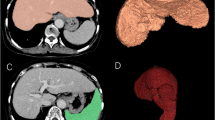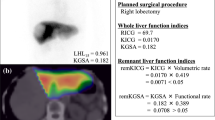Abstract
Postoperative mortality remains high after hepatectomy compared with other types of surgery in patients who have cirrhosis or chronic hepatitis. Although there are several useful perioperative indicators of liver dysfunction, no standard markers are available to predict postoperative liver failure in patients with hepatocellular carcinoma (HCC) undergoing hepatectomy. The best preoperative method for evaluating the hepatic functional reserve of patients with HCC remains unclear, but technetium-99m diethylenetriamine pentaacetic acid galactosyl human serum albumin (99mTc-GSA) scintigraphy is a candidate. 99mTc-GSA is a liver scintigraphy agent that binds to the asialoglycoprotein receptor, and can be used to assess the functional hepatocyte mass and thus determine the hepatic functional reserve in various physiological and pathological states. The maximum removal rate of 99m Tc-GSA (GSA-Rmax) calculated by using a radiopharmacokinetic model is correlated with the severity of liver disease. There is also a significant difference of GSA-Rmax between patients with chronic hepatitis and persons with normal liver function. Regeneration of the remnant liver and recurrence of hepatitis C virus infection in the donor organ after living donor liver transplantation have also been investigated by 99mTc-GSA scintigraphy. This review discusses the usefulness of 99mTc-GSA scintigraphy for liver surgery.




Similar content being viewed by others
References
Morell AG, Irvine RA, Sternlieb I, Scheunberg IH, Ashwell G. Physical and chemical studies on ceruloplasmin. V. Metabolic studies on sialic acid-free ceruloplasmin in vivo. J Biol Chem. 1968;243:155–9.
Pricer WE, Ashwell G. The binding of desialylated glycoproteins by plasma membranes of rat liver. J Biol Chem. 1971;246:4825–33.
Burgess JB, Baenziger JU, Brown WR. Abnormal surface distribution of the human asialoglycoprotein receptor in cirrhosis. Hepatology. 1992;15:702–6.
Sawamura T, Kawasato S, Shiozaki Y, Sameshima Y, Nakada H, Tashiro Y. Decrease of a hepatic binding protein specific for asialoglycoproteins with accumulation of serum asialoglycoproteins in galactosamine-treated rats. Gastroenterology. 1981;81:527–33.
Sawamura T, Nakada H, Hazama H, Shiozaki Y, Sameshima Y, Tashiro Y. Hyperasialoglycoproteinemia in patients with chronic liver diseases and/or liver cell carcinoma: asiaroglycoprotein receptor in cirrhosis and liver cell carcinoma. Gastroenterology. 1984;87:1217–21.
Ha-Kawa SK, Tanaka Y, Hasebe S, Kuniyasu Y, Koizumi K, Ishii Y, et al. Compartmental analysis of asialoglycoprotein receptor scintigraphy for quantitative measurement of liver function: a multicentre study. Eur J Nucl Med. 1997;24:130–7.
Kwon AH, Ha-Kawa SK, Uetsuji S, Inoue T, Matsui Y, Kamiyama Y. Preoperative determination of the surgical procedure for hepatectomy using technetium-99m-galactosyl human serum albumin (99mTc-GSA) liver scintigraphy. Hepatology. 1997;25:426–9.
Wu J, Ishikawa N, Takeda T, Tanaka Y, Pan XQ, Sato M, et al. The functional hepatic volume assessed by 99mTc-GSA hepatic scintigraphy. Ann Nucl Med. 1995;9:229–35.
Ota T, Seki M, Morita R. Case report: focal fatty infiltration of the liver with accumulation defect on Tc-99m colloid and Tc-99m-GSA scintigraphy. Clin Radiol. 1997;52:399–401.
Tomiguchi S, Kira T, Oyama Y, Nabeshima M, Nakashima R, Tsuji A, et al. Correlation of Tc-99m GSA hepatic studies with biopsies in patients with chronic active hepatitis. Clin Nucl Med. 1995;20:717–20.
Kaibori M, Ha-Kawa SK, Uchida Y, Ishizaki M, Hijikawa T, Saito T, et al. Recurrent hepatitis C after living donor liver transplantation detected by Tc-99m GSA liver scintigraphy. Dig Dis Sci. 2006;51:2013–7.
Kaibori M, Ha-Kawa SK, Uchida Y, Ishizaki M, Saito T, Matsui K, et al. Liver regeneration in donors evaluated by Tc-99m-GSA scintigraphy after living donor liver transplantation. Dig Dis Sci. 2007;53:850–5.
Kaibori M, Ha-Kawa SK, Ishizaki M, Matsui K, Saito T, Kwon AH, et al. HA/GSA-Rmax ratio as a predictor of postoperative liver failure. World J Surg. 2008;32:2410–8.
Bosch X, Ribes J, Borras J. Epidemiology of primary liver cancer. Semin Liver Dis. 1999;19:271–85.
Taylor-Robinson SD, Foster GR, Arora S, Hargreaves S, Thomas HC. Increase in primary liver cancer in the UK 1979–94. Lancet. 1997;350:1142–3.
EI-Serag HB, Mason AC. Rising incidence of hepatocellular carcinoma in the United States. N Engl J Med. 1999;340:745–50.
Fan ST, Lai EC, Lo CM, Ng IO, Wong J. Hospital mortality of major hepatectomy for hepatocellular carcinoma associated with cirrhosis. Arch Surg. 1995;130:198–203.
Nadig DE, Wada TP, Fairchild RB, Virgo KS, Johnson FE. Major hepatic resection. Arch Surg. 1997;132:115–9.
Shimada M, Takenaka K, Fujiwara Y, Gion T, Shirabe K, Yanaga K, et al. Risk factors linked to postoperative morbidity in patients with hepatocellular carcinoma. Br J Surg. 1998;85:195–8.
Yeh CN, Chen MF, Lee WC, Jeng LB. Prognostic factors of hepatic resection for hepatocellular carcinoma with cirrhosis: univariate and multivariate analysis. J Surg Oncol. 2002;81:195–202.
Benzoni E, Cojutti A, Lorenzin D, Adani GL, Baccarani U, Favero A, et al. Liver resective surgery: a multivariate analysis of postoperative outcome and complication. Langenbecks Arch Surg. 2007;392:45–54.
Redaelli CA, Dufour JF, Wagner M, Schilling M, Husler J, Krahenbuhl L, et al. Preoperative galactose elimination capacity predicts complications and survival after hepatic resection. Ann Surg. 2002;235:77–85.
Bruix J, Castells A, Bosch J, Feu F, Fuster J, Garcia-Pagan JC, et al. Surgical resection of hepatocellular carcinoma in cirrhotic patients: prognostic value of preoperative portal pressure. Gastroenterology. 1996;111:1018–22.
Lau H, Man K, Fan ST, Yu WC, Lo CM, Wong J. Evaluation of preoperative hepatic function in patients with hepatocellular carcinoma undergoing hepatectomy. Br J Surg. 1997;84:1255–9.
Makuuchi M, Kosuge T, Takayama T, Yamazaki S, Kakazu T, Miyagawa S, et al. Surgery for small liver cancers. Semin Surg Oncol. 1993;9:298–304.
Pearl RH, Clowes GHA, Bosari S, McDermott WV, Menzoian JO, Love W, et al. Amino acid clearance in cirrhosis. A predictor of postoperative morbidity and mortality. Arch Surg. 1987;122:468–73.
Gill RA, Goodman MW, Golfus GR, Onstad GR, Bubrick MP. Aminopyrine breath test predicts surgical risk for patients with liver disease. Ann Surg. 1983;198:701–4.
Kitai T, Inomoto T, Miwa M, Shikayama T. Fluorescence navigation with indocyanine green for detecting sentinel lymph nodes in breast cancer. Breast Cancer. 2005;12:211–5.
Miyashiro I, Miyoshi N, Hiratsuka M, Kishi K, Yamada T, Ohue M, et al. Detection of sentinel node in gastric cancer surgery by indocyanine green fluorescence imaging: Comparison with infrared imaging. Ann Surg Oncol. 2008;15:1640–3.
Gotoh K, Yamada T, Ishikawa O, Takahashi H, Eguchi H, Yano M, et al. A novel image-guided surgery of hepatocellular carcinoma by indocyanine green fluorescence imaging navigation. J Surg Oncol. 2009;100:75–9.
Kaibori M, Ishizaki M, Matsui K, Kwon AH. Intraoperative indocyanine green fluorescent imaging for prevention of bile leakage after hepatic resection. Surgery. 2011;150(1):91–8.
Suou T, Yamada S, Hosho K, Yoshikawa N, Kawasaki H. Relationship between serum and hepatic 7s fragments of type IV collagen in chronic liver disease. Hepatology. 1996;23:1154–8.
Horii K, Kubo S, Hirohashi K, Kinoshita H. Changes in erythrocyte deformability after liver resection for hepatocellular carcinoma associated with chronic liver disease. World J Surg. 1999;25:85–90.
Shimahara Y, Yamamoto N, Uyama N, Okuyama H, Momoi H, Kamikawa T, et al. Significance of serum type IV collagen level of hepatectomized patients with chronic liver damage. World J Surg. 2002;26:451–6.
Kubo S, Tsukamoto T, Hirohashi K, Tanaka H, Shuto T, Takemura S, et al. Appropriate surgical management of small hepatocellular carcinomas in patients infected with hepatitis C virus. World J Surg. 2003;27:437–42.
Yachida S, Wakabayashi H, Kokudo Y, Goda F, Okada S, Maeba T, et al. Measurement of serum hyaluronate as a predictor of human liver failure after major hepatectomy. World J Surg. 2000;24:359–64.
Mizuguchi T, Katsuramaki T, Nobuoka T, Kawamoto M, Oshima H, Kawasaki H, et al. Serum hyaluronate level for predicting subclinical liver dysfunction after hepatectomy. World J Surg. 2004;28:971–6.
Kanematsu T, Takenaka K, Matsumata T, Furuta T, Sugimachi K, Inokuchi K. Limited hepatic resection effective for selected cirrhotic patients with primary liver cancer. Ann Surg. 1984;199:51–6.
Kaibori M, Matsui Y, Hijikawa T, Uchida Y, Kwon AH, Kamiyama Y. Comparison of limited and anatomic hepatic resection for hepatocellular carcinoma with hepatitis C. Surgery. 2006;139:385–94.
Hayashi M, Fujii K, Kiuchi T, Uryuhara K, Kasahara M, Takatsuki M, et al. Effects of fatty infiltration of the graft on the outcome of living-related liver transplantation. Transpl Proc. 1999;31:403.
Ito T, Kiuchi T, Egawa H, Kaihara S, Oike F, Ogura Y, et al. Surgery-related morbidity in living donors of right lobe liver graft: lessons from the first 200 cases. Transplantation. 2003;76:158–63.
Cho JY, Suh K-S, Kwon CH, Yi NJ, Lee KU. Mild hepatic steatosis is not a major risk factor for hepatectomy and regenerative power is not impaired. Surgery. 2006;139:508–15.
Iwasaki M, Takada Y, Hayashi M, Minamiguchi S, Haga H, Maetani Y, et al. Noninvasive evaluation of graft steatosis in living donor liver transplantation. Transplantation. 2004;78:1501–5.
Ha-Kawa SK, Suga Y, Ikeda K, Nagata K, Murata T, Tanaka Y. Usefulness of blood disappearance corrected hepatic uptake ratio (LHL/HH) as a hepatic functional index using 99mTc-galactosyl serum albumin. Kakuigaku. 1993;30:1333–9. (in Japanese with English abstract).
Pomfret EA, Pomposelli JJ, Gordon FD, Erbay N, Lyn Price L, Lewis WD, et al. Liver regeneration and surgical outcome in donors of right-lobe liver grafts. Transplantation. 2003;76:5–10.
Humar A, Kosari K, Sielaff TD, Glessing B, Gomes M, Dietz C, et al. Liver regeneration after adult living donor and deceased donor split-liver transplants. Liver Transpl. 2004;10:374–8.
Kwon AH, Matsui Y, Ha-Kawa SK, Kamiyama Y. Functional hepatic volume measured by technetium-99m-galactosyl-human serum albumin liver scintigraphy: comparison between hepatocyte volume and liver volume by computed tomography. Am J Gastroenterol. 2001;96:541–6.
Baltz AC, Trotter JF. Living donor liver transplantation and hepatitis C. Clin Liver Dis. 2003;7:651–65.
Gane EJ, Portmann BC, Naoumov NV, Smith HM, Underhill JA, Donaldson PT, et al. Long-term outcome of hepatitis C infection after liver transplantation. N Engl J Med. 1996;334:815–20.
Forman LM, Lewis JD, Berlin JA, Feldman HI, Lucey MR. The association between hepatitis C infection and survival after orthotopic liver transplantation. Gastroenterology. 2002;122:889–96.
Berenguer M, Ferrell L, Watson J, Prieto M, Kim M, Rayón M, et al. HCV-related fibrosis progression following liver transplantation: increase in recent years. J Hepatol. 2000;32:673–84.
Samuel D, Bizollon T, Feray C, Roche B, Ahmed SN, Lemonnier C, et al. Interferon-alpha 2b plus ribavirin in patients with chronic hepatitis C after liver transplantation: a randomized study. Gastroenterology. 2003;124:642–50.
Kiuchi T, Uemoto S, Egawa H, Kaihara S, Oike F, Yokoi A, et al. Living donor liver transplantation in Kyoto, 2001. Clin Transpl. 2001;195–201.
Ishak K, Baptista A, Bianchi L, Callea F, De Groote J, Gudat F, et al. Histological grading and staging of chronic hepatitis. J Hepatol. 1995;22:696–9.
Bedossa P, Poynard T. An algorithm for the grading of activity in chronic hepatitis C. The METAVIR Cooperative Study Group. Hepatology. 1996;24:289–93.
Author information
Authors and Affiliations
Corresponding author
Rights and permissions
About this article
Cite this article
Kaibori, M., Ha-Kawa, S.K., Maehara, M. et al. Usefulness of Tc-99m-GSA scintigraphy for liver surgery. Ann Nucl Med 25, 593–602 (2011). https://doi.org/10.1007/s12149-011-0520-0
Received:
Accepted:
Published:
Issue Date:
DOI: https://doi.org/10.1007/s12149-011-0520-0




